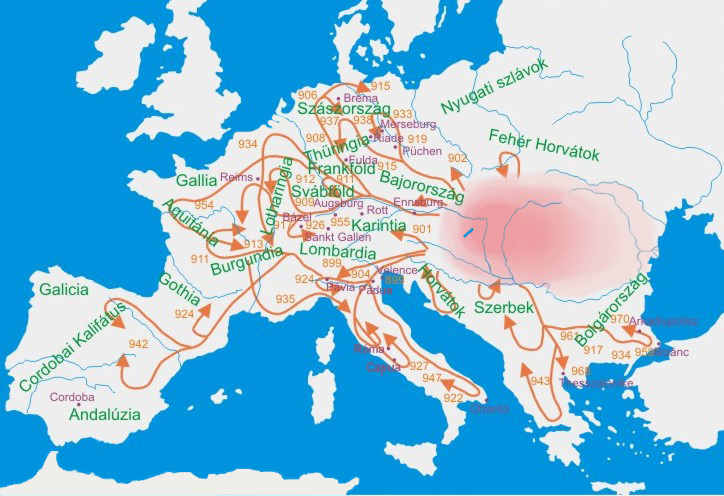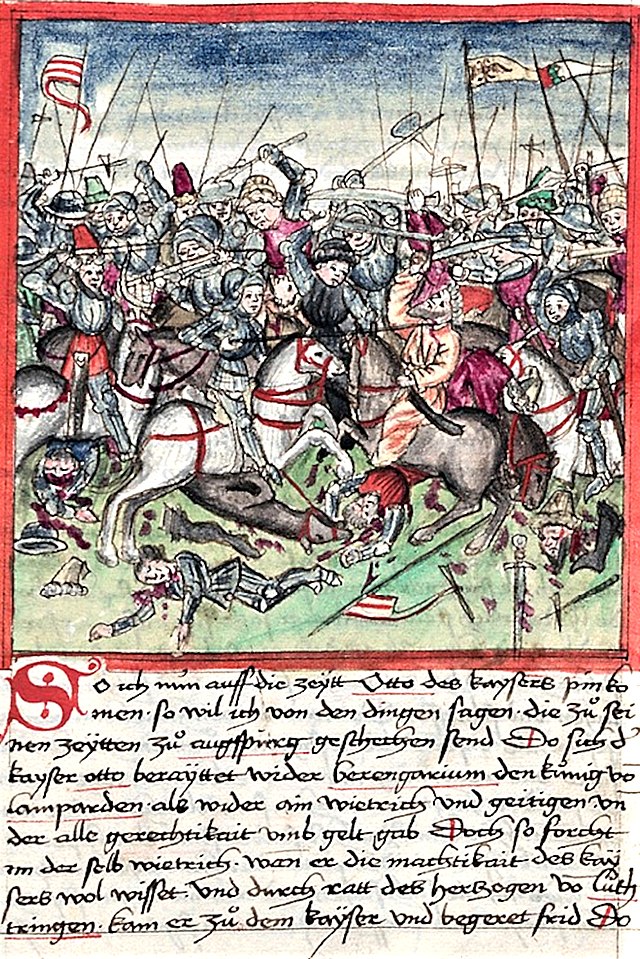The Hungarian (or Magyar) invasions of Europe took place in the ninth and tenth centuries, at a time when Europe was experiencing attacks from not only the Magyars, but also the Vikings and the Arabs. The Magyar invasions had caused much devastation throughout Europe, reaching as far as the modern-day Spain. However , the Magyars power and raiding would be finally checked at the Battle of Lechfeld in August 955.
Magyar raids in the 10th century
In 936, Otto I was crowned King of the East Franks and Saxons, he considered himself as the successor to Charlemagne. But, in 1953 Otto's son Liudolf and Conrad, the son-in-law of Otto rebelled. The rebels asked for the help of the Magyars, who invaded Bavaria in 954, this campaign was a huge financial success for the Magyars and so another army tried to repeat it the next year. The Magyars established an encampment on the eastern side of the River Lech and several raiding parties set out to pillage the surrounding countryside. The Magyars also besieged the city of Augsburg, having an army of around 6000 to 8000 men. On August 8th 955, Berchtold, the Lord of Risinesburg warned the Magyars of Otto's approaching army of around 3500 men. The Magyars lifted the siege of Augsburg and prepared a plan based on a victory in 910 when the Magyars destroyed the army of Louis the Child at Lechfeld. However, the arrival of Conrad, the exiled Duke of Lotharingia, the son-in law of Otto, who had previously asked the Magyars for aid, to support Otto was heartening. Conrad would later lose his life during this conflict.
And so the battle began.The Hungarians crossed the river and immediately attacked the Bohemians and later the Swabian legions, but they later retreated after a short fight. When Otto learned of this attack, he ordered Conrad to recover the baggage train. Conrad succeeded and returned to the main army, this was when Otto decided it was time to attack the Hungarians. Otto's army smashed into the Magyar line, despite a volley of arrows being fired at them. Otto's army was able to engage the Hungarians in hand-to-hand combat, thus allowing no room for the nomads favoured shoot and run tactics. Bulcsú, one of the Hungarian leaders, feigned a retreat, with part of his forces, in order to try and lure Otto's men into pursuit, so they would break their line. However, this failed and the Otto's men remained in formation and routed the Magyars. A pursuit of the Magyars followed for several days. On their return, the Hungarian Chieftains Lél, Bulcsú and Sur were executed. Conrad was killed when he opened up his vest due to the summer heat, as a arrow struck his throat.
The Battle of Lechfeld as depicted in Sigmund Meisterlin's codex about the history of Nuremberg
The battle had several important outcomes, as it somewhat hindered Magyar dominance, helping to bring an end to almost 100 years of raids. After 955, the Magyars ceased all raids towards the West. However, its main significance probably lies in the German lords raising Otto in their shields, in the traditional Germanic manner and proclaiming emperor. A few years later, built on the strength on this, Otto travelled to Rome and had himself crowned Holy Roman Emperor by Pope John XII. The battle has also been viewed as a symbolic victory for knightly cavalry, which would define European warfare in the High Middle Ages, over the light, nomadic cavalry, which had characterised warfare in Central and Eastern Europe during the Early Middle Ages.
Bibliography:
"The Battle of Lechfeld." - All Empires. N.p., n.d. Web. 20 June 2014.
Cavendish, Richard. "The Battle of Lechfeld." History Today. N.p., n.d. Web. 20 June 2014.
Image credit goes to Wikipedia
,
Magyar raids in the 10th century
In 936, Otto I was crowned King of the East Franks and Saxons, he considered himself as the successor to Charlemagne. But, in 1953 Otto's son Liudolf and Conrad, the son-in-law of Otto rebelled. The rebels asked for the help of the Magyars, who invaded Bavaria in 954, this campaign was a huge financial success for the Magyars and so another army tried to repeat it the next year. The Magyars established an encampment on the eastern side of the River Lech and several raiding parties set out to pillage the surrounding countryside. The Magyars also besieged the city of Augsburg, having an army of around 6000 to 8000 men. On August 8th 955, Berchtold, the Lord of Risinesburg warned the Magyars of Otto's approaching army of around 3500 men. The Magyars lifted the siege of Augsburg and prepared a plan based on a victory in 910 when the Magyars destroyed the army of Louis the Child at Lechfeld. However, the arrival of Conrad, the exiled Duke of Lotharingia, the son-in law of Otto, who had previously asked the Magyars for aid, to support Otto was heartening. Conrad would later lose his life during this conflict.
And so the battle began.The Hungarians crossed the river and immediately attacked the Bohemians and later the Swabian legions, but they later retreated after a short fight. When Otto learned of this attack, he ordered Conrad to recover the baggage train. Conrad succeeded and returned to the main army, this was when Otto decided it was time to attack the Hungarians. Otto's army smashed into the Magyar line, despite a volley of arrows being fired at them. Otto's army was able to engage the Hungarians in hand-to-hand combat, thus allowing no room for the nomads favoured shoot and run tactics. Bulcsú, one of the Hungarian leaders, feigned a retreat, with part of his forces, in order to try and lure Otto's men into pursuit, so they would break their line. However, this failed and the Otto's men remained in formation and routed the Magyars. A pursuit of the Magyars followed for several days. On their return, the Hungarian Chieftains Lél, Bulcsú and Sur were executed. Conrad was killed when he opened up his vest due to the summer heat, as a arrow struck his throat.
The Battle of Lechfeld as depicted in Sigmund Meisterlin's codex about the history of Nuremberg
The battle had several important outcomes, as it somewhat hindered Magyar dominance, helping to bring an end to almost 100 years of raids. After 955, the Magyars ceased all raids towards the West. However, its main significance probably lies in the German lords raising Otto in their shields, in the traditional Germanic manner and proclaiming emperor. A few years later, built on the strength on this, Otto travelled to Rome and had himself crowned Holy Roman Emperor by Pope John XII. The battle has also been viewed as a symbolic victory for knightly cavalry, which would define European warfare in the High Middle Ages, over the light, nomadic cavalry, which had characterised warfare in Central and Eastern Europe during the Early Middle Ages.
Bibliography:
"The Battle of Lechfeld." - All Empires. N.p., n.d. Web. 20 June 2014.
Cavendish, Richard. "The Battle of Lechfeld." History Today. N.p., n.d. Web. 20 June 2014.
Image credit goes to Wikipedia
,


No comments:
Post a Comment